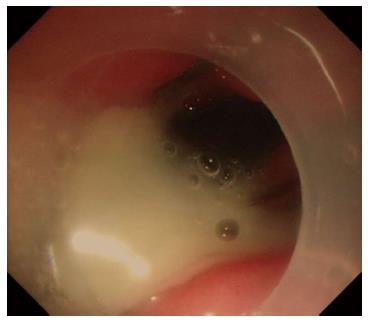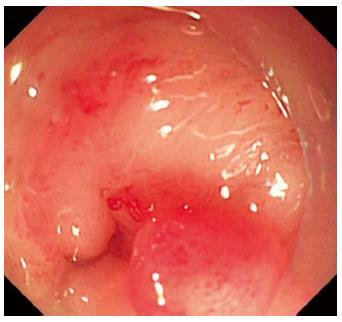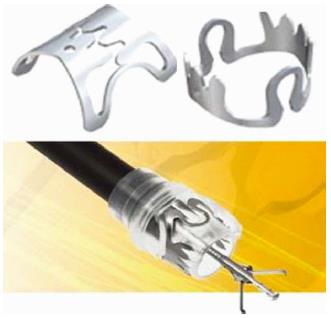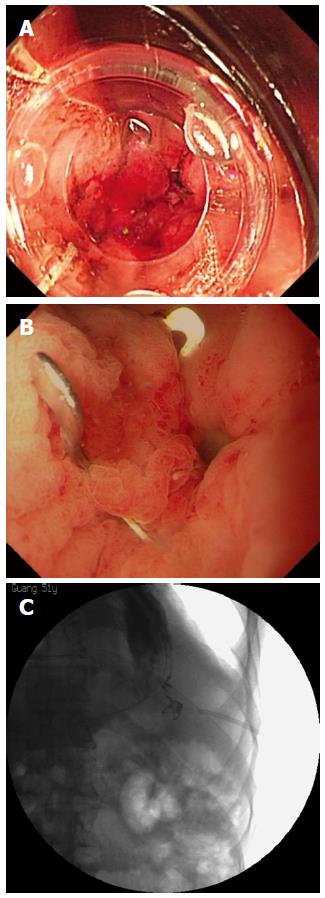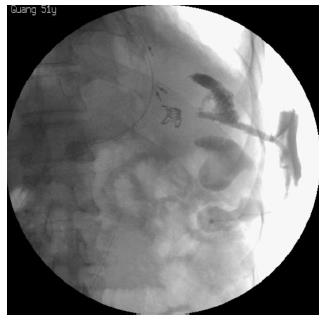Published online Dec 21, 2015. doi: 10.3748/wjg.v21.i47.13396
Peer-review started: April 20, 2015
First decision: May 18, 2015
Revised: June 15, 2015
Accepted: September 13, 2015
Article in press: September 14, 2015
Published online: December 21, 2015
Processing time: 239 Days and 15.8 Hours
Over-the-scope clip (OTSC) system is becoming a new reliable technique which is available for the endoscopic closure of fistulas, bleeding, perforations and so on. We describe the case of a patient with a non-healing gastrocutaneous fistula after esophagectomy for esophageal squamous cell carcinoma which was successfully closed using an OTSC system. This is the first report of the use of OTSC to treat a non-healing gastrocutaneous fistula successfully after esophagectomy. We believe our experience will give such patients an ideal way to cure the fistula without suffering too much and also explore new application of OTSC.
Core tip: Gastrocutaneous fistula after esophagectomy is infrequent, but it is notorious for the difficulty of achieving closure. We describe the case of a patient with a non-healing gastrocutaneous fistula after esophagectomy for esophageal squamous cell carcinoma which was successfully closed using an over-the-scope clip (OTSC) system. This is the first report of the use of OTSC to treat this type of gastrocutaneous fistula.
- Citation: Shen SS, Zhang XQ, Li ZL, Zou XP, Ling TS. Over-the-scope clip to close a gastrocutaneous fistula after esophagectomy. World J Gastroenterol 2015; 21(47): 13396-13399
- URL: https://www.wjgnet.com/1007-9327/full/v21/i47/13396.htm
- DOI: https://dx.doi.org/10.3748/wjg.v21.i47.13396
Radical surgery for esophageal squamous cell carcinoma is the first-line option for most patients, however, refractory gastrocutaneous fistula is a recognized complication. Here we describe the case of a patient with a non-healing gastrocutaneous fistula after esophagectomy for esophageal squamous cell carcinoma which was successfully closed using an over-the-scope clip (OTSC) system.
The patient was a 51-year-old man who was diagnosed with esophageal squamous cell carcinoma which was located 20-24 cm from the incisor teeth in September 2011 and subsequently underwent radical esophagectomy using the Ivor-Lewis method. The pathological type was esophageal squamous cell carcinoma with moderate differentiation and the TNM stage was T2N1M0. Two months after surgery, he developed a fever, systemic inflammatory response syndrome and a gastrocutaneous fistula with purulent secretion appearing on the left wall of his chest. The fistula was located in the 6th intercostal space of the left anterior axillary line on the chest. Endoscopy was applied and found that the esophagogastric anastomosis was located 18 cm from the incisor teeth and the gastrocutaneous fistula was situated 37 cm from the incisor teeth. The gastrocutaneous fistula in the stomach was approximately 1 cm × 1 cm in size and there was abscess in the fistula. Since the complication occurred so promptly after surgery that he did not accept any other therapies for the tumor itself such as radiotherapy from then on. Subsequently, he underwent drainage of the abscess with a tube placed in the chest. Meanwhile, the patient had been fasted and received gastrointestinal decompression therapy and nose-jejunum nutrition support for 28 mo before coming to our hospital in February 2014. Endoscopic titanium clip closure was attempted to close the fistula in the stomach in January 2014 but failed. The patient lost 40 pounds of weight before admission to our hospital and had a low quality of life. The reason why the patient suffered such long time nose-jejunum nutrition may be that the fistula size was big and could not be sealed after local drainage and systemic antibiotic administration. Prior to any therapeutic procedure, an endoscopy was performed in our hospital and revealed a purulent secretion flowing from the fistula (Figure 1). Closing the fistula with pus may aggravate the infection, therefore no step was taken to seal the fistula. Instead, a drainage tube was placed in the chest. The depth of the tube in the fistula was about 7 cm. One side of the tube was placed in the remnant stomach and the other side was on the chest. Antibiotics were administered to control the infection. After 42 d of comprehensive treatments and when the drainage liquid turned to clear, a second endoscopy was performed, which revealed no obvious purulent secretion in the fistula and the diameter of the fistula was about 1 cm × 1 cm (Figure 2). The gastric aspect of the fistula was successfully closed with the 11/6t OTSC system (Ovesco Endoscopy GmbH, Tubingen, Germany). The OTSC system was placed on the tip of the endoscope, the margins of the fistula were apposed with graspers, and the clip was then deployed by using the external hand wheel and “anchor” to allow precise alignment between the target tissue and the applicator cap. Immediate closure of the fistula was confirmed by the inability to flush water through the stomach into the fistula (Figures 3 and 4A). The patient was discharged 3 d later with semiliquid food by mouth and returned to our hospital 21 d later to check the closure of the fistula without any symptoms. Upper gastrointestinal endoscopy showed that the OTSC was still in place and the fistula disappeared (Figure 4B). Omnipaque injected through the endoscope verified the watertight closure of the fistula (Figure 4C). Closure of the fistula was also confirmed by the inability to leak Omnipaque from the chest to the stomach (Figure 5).
Due to the chronic inflammation and infection in the patient, repeat surgery would have been technically difficult and endoscopic intervention was required in such situation. Several methods have been described for closing non-healing gastrocutaneous fistulas, including endoscopic clips, fibrin glue, sutures, stents and a combination of these techniques[1]. Because of the failure of the titanium clip and other traditional methods not being suitable for this patient with a persistent fistula, we decided to close the fistula using the OTSC system. Its capacity of grasping more visceral tissue and applying a greater compressive force is thought to achieve a sturdy closure of the gastrocutaneous fistula[2]. There have been some case reports about gastrocutaneous fistulas after sleeve gastrectomy, percutaneous endoscopic gastrostomy removal and gastric bypass sealed with the OTSC device[3-5]. This is the first report of the use of OTSC to treat a non-healing gastrocutaneous fistula after esophagectomy. The short-term closure was confirmed in our case. However, the long-term outcome needs to be further explored.
The middle-aged male patient presented with a non-healing gastrocutaneous fistula which was located in the 6th intercostal space of the left anterior axillary line on the chest after esophagectomy for esophageal squamous cell carcinoma.
A fever, systemic inflammatory response syndrome and a gastrocutaneous fistula with purulent secretion appeared on the left wall of the chest which was located in the 6th intercostal space of the left anterior axillary line.
Fistula caused by inflammatory bowel disease and subcutaneous infection.
WBC 12 × 109/L; N 90%; HGB 90 g/L; liver and kidney function tests were within normal limits.
Gastrocutaneous fistula was situated 37 cm from the incisor teeth with approximately 1 cm × 1 cm in size and there was abscess in the fistula by endoscopy.
After systemic antibiotic treatments and sufficient drainage on the chest, the gastric aspect of the fistula was successfully closed with the 11/6t over-the-scope clip (OTSC) system (Ovesco Endoscopy GmbH, Tubingen, Germany).
There have been some case reports about gastrocutaneous fistulas after sleeve gastrectomy, percutaneous endoscopic gastrostomy removal and gastric bypass sealed with the OTSC device.
OTSC system designed by Ovesco Endoscopy GmbH, Tubingen, Germany, represents a new class of endoscopic clips providing significantly more strength and better tissue capture compared to conventional clips delivered through the working channel of the flexible endoscope.
This is the first report of the use of OTSC to treat a non-healing gastrocutaneous fistula after esophagectomy and the short-term closure was confirmed in our case, however, the long-term outcome needs to be further explored.
The notorious non-healing gastrocutaneous fistula after esophagectomy for esophageal squamous cell carcinoma can be successfully closed using an OTSC system.
P- Reviewer: Mathisen DJ, Shiryajev YN S- Editor: Yu J L- Editor: Wang TQ E- Editor: Liu XM
| 1. | Kumar N, Thompson CC. Endoscopic therapy for postoperative leaks and fistulae. Gastrointest Endosc Clin N Am. 2013;23:123-136. [RCA] [PubMed] [DOI] [Full Text] [Cited by in Crossref: 46] [Cited by in RCA: 51] [Article Influence: 4.3] [Reference Citation Analysis (1)] |
| 2. | Nishiyama N, Mori H, Kobara H, Rafiq K, Fujihara S, Kobayashi M, Oryu M, Masaki T. Efficacy and safety of over-the-scope clip: including complications after endoscopic submucosal dissection. World J Gastroenterol. 2013;19:2752-2760. [RCA] [PubMed] [DOI] [Full Text] [Full Text (PDF)] [Cited by in CrossRef: 101] [Cited by in RCA: 111] [Article Influence: 9.3] [Reference Citation Analysis (0)] |
| 3. | Aly A, Lim HK. The use of over the scope clip (OTSC) device for sleeve gastrectomy leak. J Gastrointest Surg. 2013;17:606-608. [RCA] [PubMed] [DOI] [Full Text] [Cited by in Crossref: 23] [Cited by in RCA: 26] [Article Influence: 2.2] [Reference Citation Analysis (0)] |
| 4. | Sandmann M, Heike M, Faehndrich M. Application of the OTSC system for the closure of fistulas, anastomosal leakages and perforations within the gastrointestinal tract. Z Gastroenterol. 2011;49:981-985. [RCA] [PubMed] [DOI] [Full Text] [Cited by in Crossref: 44] [Cited by in RCA: 42] [Article Influence: 3.0] [Reference Citation Analysis (0)] |
| 5. | Donatelli G, Vergeau BM, Dumont JL, Tuszynski T, Dritsas S, Dhumane P, Meduri B. Late presentation of a giant gastrogastric fistula following gastric bypass, treated with a colic over-the-scope clip after unsuccessful surgical repair. Endoscopy. 2014;46 Suppl 1 UCTN:E128-E129. [RCA] [PubMed] [DOI] [Full Text] [Cited by in Crossref: 3] [Cited by in RCA: 4] [Article Influence: 0.4] [Reference Citation Analysis (0)] |













